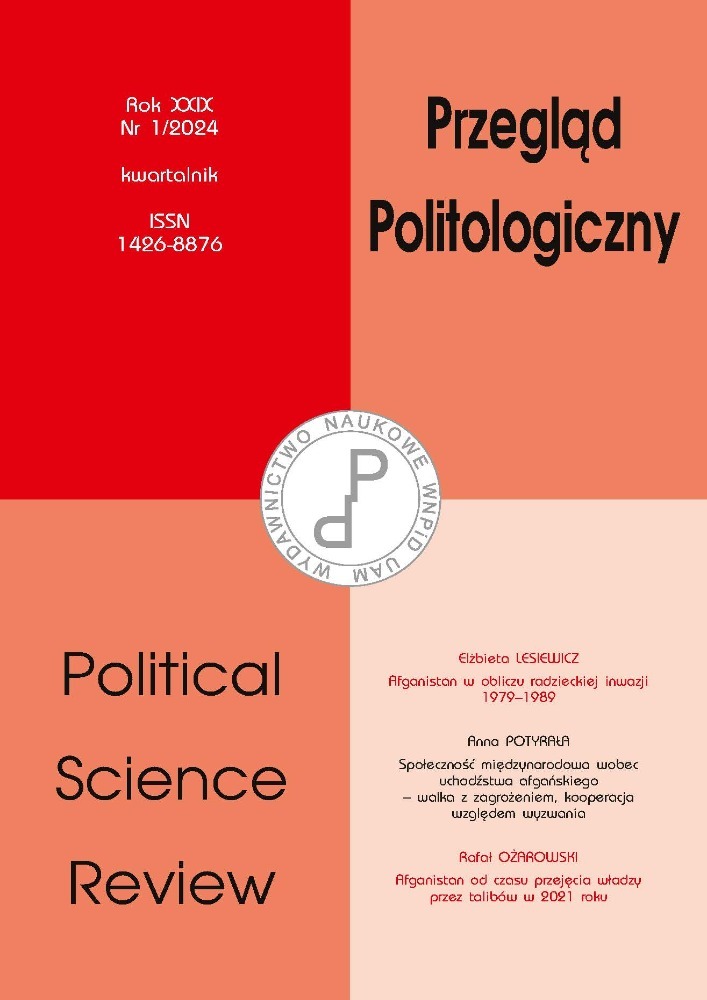Abstract
The Taliban victory in Afghanistan in 2021 has not only raised geopolitical concerns but has also sparked questions about the state’s policies and strategies concerning its rare earth elements reserves. The main objective of the presented article is to indicate how the current political change in Afghanistan may affect the raw material policy regarding the extraction of rare earth elements, taking into account geopolitical factors. Rare earth elements are a group of critical minerals that are of great importance to modern technologies, ranging from electronics and renewable energy to defence systems. Afghanistan is known to possess significant deposits of these valuable resources, which have the potential to play a crucial role in global supply chains, especially in the face of ongoing rivalry between the People’s Republic of China and the United States of America. The research problem of the considerations undertaken in this article is to assess the key challenges and opportunities in harnessing Afghanistan’s rare earth element resources after the Taliban’s return to power. The research conducted shows that despite having a significant amount of rare earth elements, Afghanistan lacks the infrastructure necessary to extract and process these valuable minerals. After the Taliban victory, the newly established government sees the potential benefit in extracting rare earth elements and is willing to align itself with China to exploit them.
References
Afghanistan Extractive Industries Transparency Initiative (2016), Inception Report and Fourth Reconciliation Report, https://eiti.org/sites/default/files/attachments/2012-2013_afghanistan_eiti_report.pdf, 12.01.2024.
Baskaran G. (2024), What China’s Ban on Rare Earths Processing Technology Exports Means, https://www.csis.org/analysis/what-chinas-ban-rare-earths-processing-technology-exports-means, 10.01.2024.
Cash J., Noori M., Greenfield Ch. (2023), Taliban plans to formally join China’s Belt and Road Initiative, https://www.mining.com/web/taliban-says-plans-to-formally-join-chinas-belt-and-road-initiative/, 22.12.2023.
Chandrashekar TS. (2021), The Great Game over Rare Earth Minerals in Afghanistan, https://samvadaworld.com/big-block-of-4/the-great-game-over-rare-earth-minerals-in-afghanistan/, 8.12.2023.
Dobrescu E. (2023), The Rare Earths Economy, MultiMedia Publishing, Bucharest. DOI: https://doi.org/10.58679/tw70453
European Commission (2023), Batteries and mining, https://knowledge4policy.ec.europa.eu/biodiversity/batteries-mining_en, 15.09.2023.
Fazl-e-Haider S. (2023), Is China engaged in resource politics in Afghanistan?, https://www.thinkchina.sg/china-engaged-resource-politics-afghanistan, 04.12.2023.
Ginsburgs G. (1987), Calendar of Soviet Treaties, Martinus Nijhoff Publishers, Dordrecht.
Global Times (2021), US in no position to meddle with potential rare-earth cooperation between China and Afghanistan, https://www.globaltimes.cn/page/202108/1231893.shtml, 20.12.2023.
Haynes J. (2008), Development Studies, Polity Press, Cambridge.
Hussein M., Haddad M. (2021), Mapping Afghanistan’s untapped natural resources, https://www.aljazeera.com/news/2021/9/24/mapping-afghanistans-untapped-natural-resources-interactive, 21.12.2023.
Kalantzakos S. (2018), China and the geopolitics of rare earths, Oxford University Press, New York. DOI: https://doi.org/10.1093/oso/9780190670931.001.0001
Marlow I., Curran E. (2021), As US exits Afghanistan, China eyes 1$ trillion in minerals, https://www.aljazeera.com/news/2021/8/24/as-us-exits-afghanistan-china-eyes-1-trillion-in-minerals, 19.12.2023.
Ministry of Mines and Petroleum (2019), Afghanistan – Mining Regulations 2019, https://policy.asiapacificenergy.org/node/4062, 12.01.2024.
Montgomery S. (2021), Afghanistan has vast mineral wealth but faces steep challenges to tap it, https://theconversation.com/afghanistan-has-vast-mineral-wealth-but-faces-steep-challenges-to-tap-it-166484, 24.09.2023.
Nguyen M., Onstad E. (2023), China’s rare earths dominance in focus after it limits germanium and gallium exports, https://www.reuters.com/markets/commodities/chinas-rare-earths-dominance-focus-after-mineral-export-curbs-2023-07-05/, 02.01.2024.
Nojumi N. (2016), American State-Building in Afghanistan and Its Regional Consequences. Achieving Democratic Stability and Balancing China’s Influence, Rowman and Littlefield Publishers, Lanham.
Polish Economic Institute (2023), 98% of EU demand for rare-earth elements is met by China, https://pie.net.pl/en/98-of-eu-demand-for-rare-earth-elements-is-met-by-china/, 12.11.2023.
Rosenberg J. M. (2022), The Belt and Road Initiative. The Threat of an Economic Cold War with China, Lexington Books, London.
Saunders P. (2021), Energy technology in an Era of Great Power Competition. Challenges and Opportunities in U.S.-Japan and U.S.-South Korea Cooperation, Energy Innovation Reform Project, Arlington.
Schneider H. (2024), Beijing’s motivation in China-Taliban relations, https://www.gisreportsonline.com/r/china-taliban-relations/, 16.03.2024.
Shroder J. (2014), Natural Resources in Afghanistan, Elsevier, San Diego. DOI: https://doi.org/10.1016/B978-0-12-800135-6.00014-3
Smelror M., Hanghoj K., Schiellerup H. (2023), The Green Stone Age: Exploration and Exploitation of Minerals for Green Technologies, The Geological Society Publishing House, Brassmill Lane. DOI: https://doi.org/10.1144/SP526
Specialeurasia (2023), Exploring Iran-Afghanistan collaboration: Kabul’s Pursuit of Trade Diversification, https://www.specialeurasia.com/2023/12/04/iran-afghanistan-cooperation/, 03.01.2024.
Tan W. (2021), China may align itself with Taliban and try to exploit Afghanistan’s rare earth metals, analyst warns, https://www.cnbc.com/2021/08/17/taliban-in-afghanistan-china-may-exploit-rare-earth-metals-analyst-says.html, 20.09.2023.
The Economic Times (2023), Chine eyes Afghanistan’s lithium reserves, offers to invest USD 10 billion, https://economictimes.indiatimes.com/news/international/world-news/china-eyes-afghanistans-lithium-reserves-offers-to-invest-usd-10-billion/articleshow/99521732.cms?from=mdr, 03.01.2024.
Tiess G., Majumder T., Cameron P. (2023), Encyclopedia of Mineral and Energy Policy, Springer, Berlin. DOI: https://doi.org/10.1007/978-3-662-47493-8
Trumpwhitehouse (2017), Readout of President Donald J. Trump’s Meeting with President Ashraf Ghani of Afghanistan, https://trumpwhitehouse.archives.gov/briefings-statements/readout-president-donald-j-trumps-meeting-president-ashraf-ghani-afghanistan/, 22.10.2023.
Trumpwhitehouse (2020), President Donald J. Trump Is Protecting Our Domestic Mining Industry and Critical Minerals Supply Chains, https://trumpwhitehouse.archives.gov/briefings-statements/president-donald-j-trump-protecting-domestic-mining-industry-critical-minerals-supply-chains/, 23.10.2023.
U.S. Department of the Interior, U.S. Geological Survey (2013), Minerals Yearbook. Area Reports: International 2013. Asia and the Pacific, United States Government Printing Office, Washington.
United States Geological Survey (2011), Summaries of Important Areas for Mineral Investment and Production Opportunities of Nonfuel Minerals in Afghanistan, https://pubs.usgs.gov/of/2011/1204/, 21.11.2023.
Wilson M. B. (2013), Impacts of Participatory Development in Afghanistan, Walter de Gruyter, Berlin. DOI: https://doi.org/10.1515/9783112209059
Yunus Yawar M. (2022), China „shocked” at Kabul hotel attack that injured its five citizens, https://www.reuters.com/world/asia-pacific/five-chinese-citizens-badly-injured-kabul-attack-businessman-says-2022-12-13/, 04.12.2023.
License
Copyright (c) 2024 Rafał Kamprowski

This work is licensed under a Creative Commons Attribution-ShareAlike 4.0 International License.

